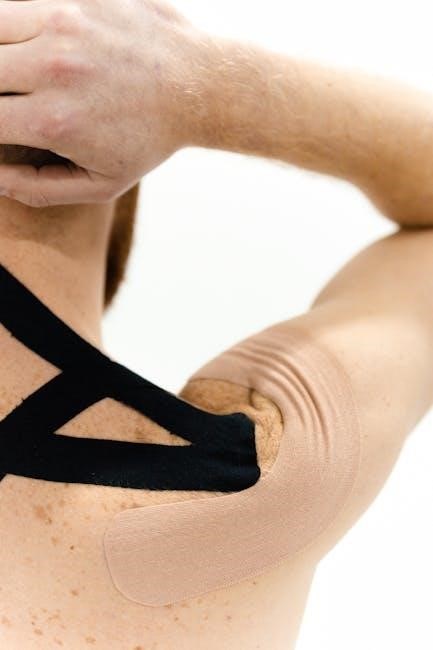
Thoracic mobility refers to the movement and flexibility of the thoracic spine, essential for posture, breathing, and overall physical function. Improving thoracic mobility enhances spinal health.
1.1 Importance of Thoracic Spine Mobility
Thoracic spine mobility is crucial for maintaining proper posture, facilitating breathing, and enabling efficient movement. Limited mobility can lead to poor posture, upper back pain, and restricted respiratory function. Enhancing thoracic mobility improves spinal alignment, reduces muscle tension, and promotes overall physical performance. It also supports athletic activities by allowing better rotation and flexibility. Incorporating thoracic mobility exercises into daily routines can significantly enhance spinal health and prevent long-term musculoskeletal issues. Proper mobility ensures optimal functioning of the thoracic region, contributing to better overall well-being and physical efficiency.
1.2 Common Issues Related to Thoracic Spine Misalignment
Thoracic spine misalignment often leads to poor posture, upper back pain, and limited mobility. Conditions like kyphosis can restrict thoracic extension and rotation, impacting breathing and movement. Misalignment may cause muscle imbalances, leading to chronic discomfort and stiffness. Restricted thoracic mobility can also result in compensatory movements, straining the shoulders and neck. Addressing these issues through targeted exercises and proper alignment techniques is essential for restoring function and reducing discomfort in the thoracic region and surrounding areas.
Benefits of Thoracic Mobility Exercises
Thoracic mobility exercises enhance flexibility, improve posture, and reduce upper back pain. They promote better breathing mechanics and overall spinal health, boosting athletic performance and daily activities.
2.1 Improved Posture
Improved posture is a key benefit of thoracic mobility exercises. By enhancing the flexibility and movement of the thoracic spine, these exercises help correct rounded shoulders and reduce kyphosis.
Regular practice strengthens the muscles supporting the spine, promoting a more upright and balanced posture. This reduces strain on the neck and lower back, enhancing overall comfort and confidence in daily activities.
2.2 Reduced Upper Back Pain
Thoracic mobility exercises are highly effective in reducing upper back pain by addressing stiffness and misalignment in the thoracic spine. Tight muscles and poor posture often contribute to discomfort, which these exercises help alleviate. By improving spinal flexibility and strength, thoracic mobility exercises can significantly decrease tension in the upper back, promoting long-term relief and better overall spinal health.
2.3 Enhanced Athletic Performance
Thoracic mobility exercises significantly enhance athletic performance by improving rotational power, movement efficiency, and overall flexibility. Enhanced spinal rotation allows athletes to generate more force in activities like golf swings or tennis serves. Improved mobility also reduces the risk of injuries by ensuring proper movement mechanics. Additionally, better thoracic mobility enhances coordination and balance, giving athletes a competitive edge in their respective sports. Incorporating these exercises into training routines can lead to noticeable improvements in performance and longevity in athletic careers.
2.4 Better Breathing Mechanics
Thoracic mobility exercises improve breathing mechanics by enhancing the expansion and contraction of the chest cavity. A mobile thoracic spine allows the ribs to move more freely, increasing lung capacity and promoting deeper, more efficient breaths. This is particularly beneficial for athletes and individuals with respiratory conditions, as it enhances oxygen intake and reduces breathing effort. Improved breathing mechanics also support overall relaxation and stress reduction, contributing to better physical and mental well-being.
Types of Thoracic Mobility Exercises

Thoracic mobility exercises include dynamic stretches, mobility drills, strength training, yoga-based movements, and Pilates-based exercises, all designed to enhance flexibility, strength, and spinal movement effectively.
3.1 Dynamic Stretches

Dynamic stretches are active movements that improve thoracic spine flexibility and range of motion. Examples include arm circles, torso twists, and cat-cow exercises. These stretches enhance mobility by engaging the muscles surrounding the thoracic spine, promoting better movement patterns. Regular practice can reduce stiffness and improve posture. Dynamic stretches are particularly effective as a warm-up or cool-down for workouts. They prepare the body for physical activity and aid in recovery. Incorporating these exercises into a daily routine can significantly enhance thoracic mobility and overall spinal health.
3.2 Mobility Drills
Mobility drills are structured exercises designed to target the thoracic spine’s rotational and extensional movements. These drills often involve tools like foam rollers or resistance bands to enhance effectiveness. Examples include thoracic rotations and spinal waves. Mobility drills help break down restrictive tissue and improve joint articulation. They are particularly beneficial for individuals with limited spinal movement or those recovering from injuries. Consistent practice of these drills can lead to improved flexibility, better posture, and reduced upper back pain, making them a valuable addition to any thoracic mobility routine.
3.3 Strength Training Exercises
Strength training exercises play a crucial role in enhancing thoracic spine stability and muscular endurance. Exercises like Superman, Bird Dog, and Deadbug target the muscles surrounding the thoracic spine, improving posture and reducing upper back pain. These movements help build core strength, which is essential for maintaining proper spinal alignment during daily activities and athletic performances. Regular practice of these exercises can lead to better mobility and overall spinal health, but it’s important to focus on controlled movements to avoid injury and maximize benefits.
3.4 Yoga-Based Movements
Yoga-based movements are excellent for improving thoracic mobility by combining flexibility and strength. Poses like Cat-Cow, Cobra, and Child’s Pose gently enhance spinal movement. Twists such as Seated Spinal Twist and Triangle Pose target thoracic rotation, improving posture and reducing stiffness. These movements promote deep breathing, which relaxes the thoracic muscles and enhances overall spinal alignment. Regular yoga practice can lead to better mobility and reduced upper back pain, making it a holistic approach to thoracic spine health.
3.5 Pilates-Based Exercises
Pilates-based exercises are highly effective for enhancing thoracic mobility by focusing on controlled movements and core engagement. Exercises like the Spine Twist and Rolling enhance flexibility and strength in the thoracic region. These movements promote proper spinal alignment and improve posture. Pilates also emphasizes deep breathing, which helps relax tight muscles and improve mobility. By incorporating Pilates into your routine, you can achieve better thoracic movement, reduce upper back pain, and enhance overall spinal health. These exercises are adaptable to various fitness levels, making them a versatile option for improving thoracic mobility.
Creating a Thoracic Mobility Routine
A well-structured routine incorporates daily stretches, weekly progressions, and proper warm-ups. Consistency is key to improving mobility, reducing pain, and enhancing spinal health over time.
4.1 Daily Routine Recommendations
A daily thoracic mobility routine should include 10-30 minutes of targeted exercises. Start with dynamic stretches to warm up, followed by mobility drills like spinal rotations and extensions. Incorporate strength training exercises to stabilize the spine and improve flexibility. Yoga-based movements, such as cat-cow stretches, can enhance thoracic movement; Finish with gentle cool-down stretches to promote relaxation and maintain range of motion. Consistency is key to achieving long-term improvements in posture, reducing upper back pain, and enhancing overall spinal health.
4.2 Weekly Schedule for Progression
A weekly schedule for thoracic mobility should progress gradually to avoid plateaus. Start with foundational exercises like dynamic stretches and foam roller techniques on Mondays and Wednesdays. Introduce more challenging mobility drills, such as spinal rotations and extensions, on Tuesdays and Thursdays. Dedicate Fridays to strength training exercises, focusing on stabilizing muscles. Saturdays can include yoga-based movements for flexibility and relaxation. Sundays should be reserved for active recovery, such as light stretches or gentle Pilates exercises. Adjust the intensity and complexity of exercises based on progress and comfort levels.
4.3 Warm-Up Techniques
Effective warm-up techniques for thoracic mobility include dynamic stretches, light cardio, and breathing exercises. Begin with arm circles, shoulder rolls, and gentle twists to prepare the upper body. Incorporate thoracic rotations using a foam roller or resistance band to enhance spinal movement. Light cardio, such as brisk walking or jogging in place, increases blood flow and flexibility. Conclude with deep breathing exercises to relax the muscles and improve posture. These techniques prepare the thoracic spine for more intense exercises, reducing injury risk and enhancing mobility.
4.4 Cool-Down Stretches
Cool-down stretches are crucial for relaxing muscles after thoracic mobility exercises. Gentle movements like cat-cow stretches and thoracic rotations help reduce tension. Incorporate child’s pose or seated forward folds to release the upper back and improve flexibility. Holding stretches for 20-30 seconds enhances relaxation and prevents stiffness. Deep breathing during stretches promotes relaxation and maintains spinal alignment. These exercises ensure a smooth transition post-workout, supporting long-term mobility and spinal health.
4.5 Incorporating Exercises into Existing Workout Plans
Easily integrate thoracic mobility exercises into your current workout routine by adding them as a warm-up or cool-down. Start with dynamic stretches like arm circles and spinal twists to prepare your body. Incorporate strength training exercises such as bent-over rows and superman poses to build stability. For cardio days, include thoracic rotations and cat-cow stretches to enhance flexibility. This balanced approach ensures improved posture, reduced upper back pain, and better breathing mechanics, making your overall fitness program more effective and sustainable over time.

Role of Equipment in Thoracic Mobility
Equipment like foam rollers, exercise balls, and resistance bands play a crucial role in enhancing thoracic mobility. They provide support, deepen stretches, and improve spinal stability during exercises.
5.1 Exercises Without Equipment
Exercises without equipment are ideal for improving thoracic mobility. Simple movements like cat-cow stretches, thoracic rotations, and prayer stretches enhance flexibility and reduce stiffness. These exercises can be performed anywhere, making them perfect for daily routines. They focus on natural movement patterns, promoting better posture and reducing upper back pain. Incorporating these exercises into your routine strengthens the muscles around the thoracic spine, improving overall mobility without the need for specialized tools or equipment, making them accessible and effective for everyone.
5.2 Use of Resistance Bands
Resistance bands are versatile tools for enhancing thoracic mobility. They provide gentle to moderate tension, helping to improve flexibility and posture. Banded thoracic rotations and chest-opening exercises are effective for targeting tight muscles. Loop the band around a stable object or hold it in your hands to perform controlled movements. These exercises can strengthen the muscles surrounding the thoracic spine while increasing range of motion; Resistance bands are portable and cost-effective, making them ideal for home workouts or travel, ensuring consistent practice for better spinal health and mobility.
5.3 Foam Roller Techniques
Foam rollers are excellent tools for self-myofascial release, targeting the thoracic spine to improve mobility. By rolling over the upper back, you can release tension in the muscles surrounding the thoracic spine. Techniques involve slow, controlled movements, applying gentle to moderate pressure. This helps reduce muscle stiffness, enhance blood flow, and promote better spinal alignment. Regular use of a foam roller can complement other exercises, making it easier to achieve and maintain thoracic mobility. It’s a cost-effective and accessible method for improving spinal health at home.
5.4 Exercise Ball Workouts
Exercise balls, or stability balls, are versatile tools for improving thoracic mobility. Techniques like thoracic extensions and rotations on the ball can enhance spinal flexibility. By lying on the ball and gently arching or twisting the upper back, you can target the thoracic spine. These exercises strengthen core muscles, improve posture, and reduce muscle tension. The instability of the ball engages stabilizers, promoting better movement patterns. Regular use can complement other mobility practices, making it an effective addition to a thoracic mobility routine.

Nutrition and Recovery for Thoracic Mobility
Nutrition plays a key role in supporting thoracic mobility by providing essential nutrients for spinal health. A balanced diet, proper hydration, and adequate rest aid muscle recovery and flexibility.
6.1 Role of Nutrition in Supporting Spinal Health
Proper nutrition is vital for maintaining spinal health, as it provides the building blocks for tissue repair and inflammation reduction. A diet rich in vitamins, minerals, and antioxidants supports disc health and joint function. Anti-inflammatory foods, such as omega-3 fatty acids and turmeric, can reduce spinal inflammation. Hydration is crucial for maintaining spinal disc flexibility and cushioning. Avoiding processed sugars and excessive caffeine helps prevent spinal degradation. A balanced diet ensures optimal spinal alignment and supports thoracic mobility exercises effectively.

6.2 Importance of Hydration
Hydration plays a critical role in spinal health, as water makes up a significant portion of spinal discs and joints. Proper hydration maintains disc height, reduces stiffness, and enhances joint lubrication. Even mild dehydration can impair joint mobility and muscle function, affecting thoracic spine movement. Drinking adequate water ensures spinal discs remain cushioned and flexible, supporting thoracic mobility exercises. Staying hydrated also promotes blood flow, aiding in nutrient delivery and waste removal, which is essential for spinal health and overall physical function.
6.3 Recovery Techniques for Optimal Mobility
Recovery techniques are essential for maintaining and improving thoracic mobility. Foam rolling and self-myofascial release can reduce muscle tension and enhance flexibility. Stretching exercises, particularly those targeting the upper back and shoulders, promote relaxation and reduce stiffness. Incorporating rest days allows the spine to recover, preventing overuse injuries. Additionally, techniques like contrast showers or heat therapy can improve blood flow and reduce muscle soreness. Consistent recovery practices ensure sustained progress in thoracic mobility and overall spinal health.
6.4 Sleep and Its Impact on Spinal Alignment
Sleep plays a crucial role in maintaining spinal alignment, especially in the thoracic region. Proper sleep posture, such as lying on your back with a pillow under your knees or on your side with a pillow between your knees, helps preserve spinal neutrality. A supportive mattress and pillow are essential to avoid excessive curvature or misalignment. Poor sleep posture can lead to stiffness and discomfort, while adequate rest promotes healing and reduces muscle tension, fostering better thoracic mobility and overall spinal health.

Monitoring Progress and Adjustments

Track improvements in thoracic mobility through regular assessments, goal setting, and exercise adjustments. Use visual posture checks and feedback to refine routines for optimal spinal alignment and function.
7.1 Setting Realistic Goals
Setting realistic goals is crucial for achieving progress in thoracic mobility. Start with short-term objectives, like dedicating 10-15 minutes daily to exercises. Gradually increase intensity and duration as mobility improves. Celebrate small victories, such as better posture or reduced pain, to stay motivated; Align goals with overall health and fitness aspirations to ensure consistency and long-term commitment to thoracic mobility practices.
7.2 Tracking Improvements in Mobility
Tracking improvements in thoracic mobility helps monitor progress and stay motivated. Use a journal to record daily exercises, noting increases in range of motion and reductions in stiffness. Take periodic photos or videos to assess posture changes. Incorporate tools like mobility apps or flexibility tests to quantify improvements. Regularly reassess pain levels and ease of movement during activities. Celebrate small milestones, such as deeper breathing or improved athletic performance, to maintain consistent practice and motivation.
7.3 Adjusting Exercises Based on Progress
As mobility improves, exercises should be adjusted to continue challenging the thoracic spine. Gradually increase the intensity by adding resistance bands or weights. Introduce more dynamic movements, such as rotational drills or advanced stretches. Replace basic exercises with variations that target specific mobility limitations. Incorporate functional movements that mimic daily activities or sports. Regularly reassess progress and modify the routine to avoid plateaus, ensuring continued improvement in thoracic flexibility and strength.
7.4 Using Visual Assessments for Posture
Visual posture assessments are a valuable tool for evaluating thoracic spine alignment. By analyzing photos or videos from the front, side, and back, individuals can identify imbalances, such as a rounded upper back or uneven shoulders. Regular assessments help track progress, revealing improvements in posture and mobility over time. This visual feedback motivates consistency and highlights areas needing attention. Professionals often use these assessments to tailor exercise plans, ensuring targeted improvements in thoracic mobility and overall spinal alignment. Regular check-ins also help refine routines for better results.
Thoracic mobility exercises are essential for improving posture, reducing pain, and enhancing overall spinal health. Regular practice yields long-term benefits, fostering a stronger, more flexible upper body.
8.1 Summary of Key Points
Thoracic mobility exercises are crucial for enhancing spinal flexibility, posture, and breathing. They reduce upper back pain, improve athletic performance, and promote better respiratory function. Various exercises include dynamic stretches, mobility drills, strength training, yoga, and Pilates. Consistency is key, and routines should be tailored to individual needs. Equipment like resistance bands and foam rollers can aid progress. Proper nutrition, hydration, and sleep support recovery. Monitoring progress through goal setting and visual assessments ensures optimal results. Detailed guides, such as PDF resources, offer structured plans for effective practice.
8.2 Encouragement for Consistent Practice
Consistency is key to achieving lasting improvements in thoracic mobility. Commit to regular practice, even if it’s just a few minutes daily. Celebrate small milestones, like improved posture or reduced discomfort, to stay motivated. Remember, thoracic mobility is a journey, and every effort contributes to long-term spinal health. Share your progress with a community or partner for accountability. Tracking improvements and staying positive will help you maintain dedication. Keep in mind, consistent practice leads to better movement, breathing, and overall well-being.
Additional Resources
Downloadable PDF guides, recommended reading materials, and online communities provide valuable insights and exercises for improving thoracic mobility. Explore these resources for comprehensive support.
9.1 Recommended Reading Materials
Downloadable PDF guides like “Thoracic Mobility Exercises” offer detailed routines and visual aids. Books such as “Essential Thoracic Spine Mobility” by physical therapists provide in-depth insights. Research articles from reputable journals and online resources like “Improving Thoracic Spine Flexibility” are also recommended. These materials cover exercises, stretches, and techniques to enhance thoracic mobility, suitable for both professionals and individuals seeking self-improvement. They are designed to complement workout plans and support long-term spinal health effectively.
9.2 Downloadable PDF Guides
Downloadable PDF guides like “Thoracic Mobility Exercises” and “Essential Thoracic Spine Mobility” provide structured workout plans and visual demonstrations. These resources often include step-by-step instructions, progress tracking, and safety tips. PDFs such as “Dominik Sky Planche Secrets” and “Improving Thoracic Spine Flexibility” are popular choices, offering comprehensive routines for enhancing mobility. They are easily accessible online and can be incorporated into daily routines for consistent practice and improved spinal health. These guides cater to various fitness levels, ensuring effective and safe thoracic mobility training.
9.3 Online Communities for Support
Online communities like forums, social media groups, and specialized platforms offer valuable support for thoracic mobility exercises. These spaces allow individuals to share experiences, ask questions, and learn from experts and peers. Many communities provide access to free resources, including PDF guides and video tutorials. Joining these networks can enhance motivation, offer personalized advice, and foster accountability. Popular options include fitness-focused Facebook groups and Reddit forums dedicated to spinal health. Engaging with these communities can significantly enrich your thoracic mobility journey and help achieve long-term goals effectively.